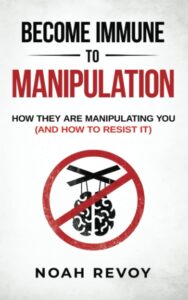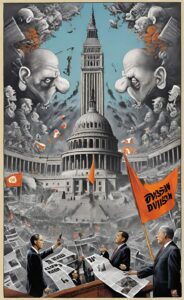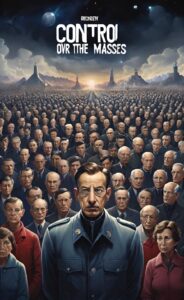From political affiliations to social identities, the media has a powerful influence on how we perceive ourselves and others. By labeling certain groups or individuals, the media creates an “us vs them” mentality, further fueling division and polarization in society.
The Power of Media in Shaping Perceptions
The realm of media holds significant sway in shaping public sentiment and perceptions. It acts as a lens through which we view the world, its power lying in the selection of words, headlines, and images it presents. Furthermore, the narrative that the media builds around a story can subtly influence our understanding and interpretation of events.
Think about it, what stories do they choose to amplify, and which ones are relegated to the back burner? The prominence given to certain news can drastically impact our worldview. Equally influential is the framing of these stories. Whether it is an emphasis on certain aspects or a complete omission of others, the media has the ability to tailor public discourse.
The power of media extends beyond the mere transmission of information. It constructs our reality, molding our understanding of events, people, and issues. By selectively presenting facts, the media can craft narratives that influence our beliefs and attitudes. In essence, the power of the media lies not just in informing us, but also in shaping our perceptions of the globasphere.
Media’s Influence on Public Discourse
Media’s place at the intersection of the public and the world provides it with an influential platform to shape discourse. By deciding which events are newsworthy and framing them according to their agenda, media outlets can subtly guide public conversation.
This, in turn, influences how communities perceive societal issues and can greatly affect discussions surrounding public policies. The power of the media, however, is a double-edged sword. While it can foster understanding and encourage productive dialogue, it also has the potential to ignite conflict and sow division. The way media handles its role as an intermediary can either lead to an environment that encourages a diversity of ideas and mutual respect, or it can cause a chasm of misunderstanding, chaos, and fear.
This is particularly apparent when media outlets present biased views or fail to represent all sides of a story, further feeding the flame of division within communities. The true test of media’s influence on public discourse, therefore, lies in its ability to balance its powerful role with a commitment to fairness and objectivity.
The Role of Media in Amplifying Existing Divisions
By choosing to showcase biased perspectives, espousing divisive rhetoric, or not fully representing the diversity of views on a topic, media outlets can inadvertently—or purposefully—stoke the flames of discord. This type of manipulation not only intensifies public disagreement, but it also fortifies divisions within our communities, making reconciliation more challenging.
While a story can be reported from numerous angles, the angle that a media outlet selects to present can say a lot about its intent. An outlet focused on objectivity and inclusivity will strive to present a balanced view, while an outlet with a specific agenda might lean more heavily on one side, further widening the chasm of division. And while it’s true that some level of bias is inherent in all forms of media, it’s the excessive bias, the calculated omission of vital viewpoints, or the consistent promotion of divisive rhetoric that threatens to drive us further apart.
Media manipulation isn’t always blatantly obvious. Sometimes, it’s as subtle as the decision to highlight certain aspects of a story over others or the choice to focus on conflict rather than consensus. But regardless of how it manifests, the result is often the same, heightened tension, entrenched divisions, and a community left struggling to find common ground in a landscape increasingly characterized by manipulation and fear news.

> Check Current Book Prices <
Manipulation of Public Opinion Through Labeling
The media’s utilization of labeling represents a particularly potent form of manipulation. Through assigning labels to individuals or groups, media can drastically shape the way we perceive them. It’s a tactic that oversimplifies the complexity of people and situations, turning them into easily digestible, one-note narratives. Negative labels can spark fear and mistrust, effectively alienating the labeled group from the rest of society. On the other hand, positive labels can create an atmosphere of support and empathy, curating public sentiment in favor of a certain group or individual.
But it’s important to note that labeling isn’t always blatant or malicious. Sometimes, it’s as subtle as referring to a group by a particular characteristic or action. However, regardless of the intention, the effect remains the same, labels affect our perception and shape our understanding, oftentimes at the cost of nuance and complexity. By recognizing this, we can become more discerning consumers of media, questioning the labels assigned and the potential biases they may reflect.



The Subtle Use of Language in Media Messaging
Media has a fascinatingly covert weapon in its arsenal, language. The words that news outlets elect to use, the tone they employ, and the context in which they present information can greatly impact our comprehension and emotional reaction to their stories. Ever wondered why one news piece evokes outrage while another inspires empathy? That’s the subtle art of language manipulation at play, a ruse tickling your nervous system.
Mainstream media often exercises strategic linguistic choices to construct narratives that subtly nudge public sentiment in a particular direction. The choice to describe a peaceful protest as a ‘demonstration’ versus a ‘riot’, for instance, can drastically alter the audience’s perception. Similarly, the use of emotionally charged words versus neutral terminology can provoke different responses. This delicate dance of words isn’t limited to the news content itself. Even headlines and captions can be carefully crafted to amplify certain perspectives or downplay others.
It’s important for us as media consumers to remain vigilant and critical of these linguistic subtleties. Let’s not be passive receivers of information, but active analyzers. Let’s challenge the language employed by the media, question its intent, and foster an environment of conscious consumption. This isn’t about casting blame on the media, but rather empowering ourselves to navigate the complex realm of news with discernment and skepticism. By recognizing the power of language in media messaging, we can encourage a more balanced and informed public discourse.
The Creation of False Dichotomies by Media Outlets
Media’s crafting of false dichotomies is another potent method of manipulation. This tactic presents situations as a battle between two diametrically opposed sides, reinforcing an “us versus them” mentality. Imagine a chessboard, black versus white, each move calculated and strategic. Media, like the puppet master, maneuvers the pieces, dictating the narrative. By simplifying intricate issues into binary choices, media outlets pave the way for division, cementing polarized perspectives.
It’s a black and white world with no room for shades of gray. This approach stifles rich, nuanced debate and curbs the possibility for mutual understanding or compromise. Picture the broad, multi-colored spectrum of opinions reduced to a stark, black and white divide. Each side of the divide becomes an echo chamber, amplifying its own views while drowning out the other’s.
This division fuels an environment of conflict, further widening the chasm between communities. As consumers of media, recognizing and challenging these false dichotomies is crucial. Let’s embrace the gray, acknowledge the complexities, and resist the lure of oversimplified narratives.












